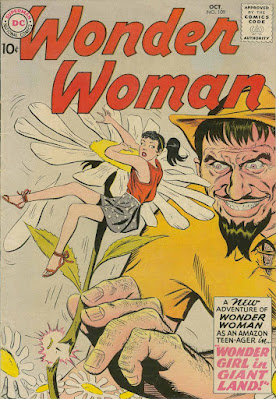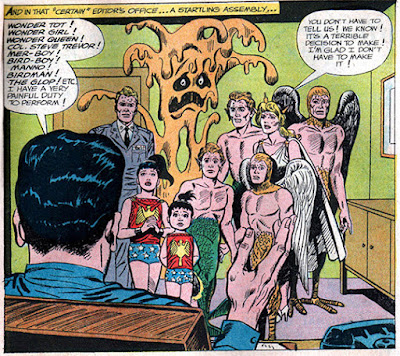The “events” to which my title refers are all the 1959-1966 appearances of DC Comics’ original “Wonder Girl” character, whose name I will henceforth abbreviate to “WG1.” Prior to 1959, the WONDER WOMAN continuity had made loose references to the idea that the heroine had passed from childhood to adulthood on Paradise Island before taking on her costumed mantle. However, in no previous period was a younger version of Wonder Woman a frequent element of the series. But in WONDER WOMAN #105, dated April 1959, writer/editor Robert Kanigher and artist Ross Andru began making repeated use of a teenaged version of the heroine, much as the feature SUPERBOY told stories of Superman when he was a youth. WG1’s adventures were sometimes featured on WONDER WOMAN covers, while at other times the teen Amazon was just a backup to her better-established older self. Not a lot of fans, even back in The Day, were especially fond of the character, though ironically WG1 indirectly spawned DC’s second Wonder Girl iteration, and that character enjoyed considerable cachet in the TEEN TITANS series-- more on which later.
Many fans, then, would have deemed WG1 an unfortunate result of editor Kanigher’s tendency to write down to the readers of WONDER WOMAN. But it only recently dawned on me that WG1 was also “un-udderable,” in a way I can only express in song:
No boobs at all,
No boobs at all,
Double-U Gee-One
Had no boobs at all!
(Approximate melody based on a song about Fawcett’s Captain Marvel, who was said to have no “balls” at all.)
While looking through one of the WG1 stories, a question occurred to me. If one presumes that Kanigher began writing stories of a teenaged Amazon, logic would dictate that he was doing so to improve sales. Movies about the new breed of American called the “teenager” had proliferated in the middle 1950s. Such films varied between stories about “clean teens” or about adolescents with somewhat raunchier proclivities. But all teen movies dealt with youths over fifteen, meaning that the female teenagers no longer looked like kids. However, WG1, despite being called a teen, always looked significantly undeveloped.
The WG1 stories do not explicitly state how old the young Amazon is. Yet in all the character’s appearances, she goes around clothed in a very loose tunic, whether it’s some Graeco-Roman garment or a version of the famous Wonder Woman costume. Since the mature Wonder Woman was reasonably well endowed, the logical conclusion is that the creators of WG1 meant to imply that the character was too young to have significant breastitude. If Kanigher was at all consistent about deeming WG1 a teenager, the youngest she could be would be thirteen, and for some individuals this can be too young for full development.
Of course, though WG1 was not technically a kid sidekick, I believe most if not all “young allies” of older superheroes were supposed to be in this same age-range. Michael Fleischer’s ENCYCLOPEDIA OF BATMAN offers evidence that Robin the Boy Wonder was supposed to be a perpetual thirteen or fourteen before he finally started aging in the late 1960s, and most boy sidekicks looked no older than Robin. Prior to WG1, there were few teenaged superheroines in comics, and the only long-lived one was Fawcett Comics’ Mary Marvel, sister of the aforementioned Captain Marvel. Mary’s age probably wasn’t stated either, but on the whole, her figure also suggested the appearance of a girl who had just recently passed into adolescence. All this circumstantial evidence suggests that the raconteurs who worked on Golden Age superheroes were convinced, probably not without merit, that most of their readers were pre-teens, and that the only ages they wanted to see represented were either (1) kids of middle school age or (2) adults, the latter embodying the fantasy of attaining temporal power. That’s also probably one reason that Kanigher decided to devote space to stories of a thirteen-year-old Amazon. The baggy clothing may have been calculated to dodge any question of the not-yet-budding youth being exploited, since a reader couldn’t even tell if she had breasts.
Of course, if you lived back in the 1950s and listened to the Abominable Doctor Wertham, all comics in all genres were replete with what the psycho psychiatrist called “headlights.” There can be little doubt that a few superheroines were especially well endowed, particularly some versions of the Phantom Lady. But most of the genres that accentuated the positive power of cleavage were those of crime, jungle-adventure, and teen-humor—the last being the only genre in which developed female teens regularly put their goods on display.
I doubt that during the middle 1950s the very conservative DC company had to clean up very much in the boobage department. Before the Code, the potential lubricity of Wonder Woman’s costume was restrained by the quasi-Classical art of H.G. Peter. After the Code, Andru and others tended to draw her as being a bit on the slender side. Most regular female characters—Lois Lane and Lana Lang (in the SUPERBOY feature) -- sported modest cleavage, while Catwoman, one of the few well-endowed DC femmes, found herself placed in exile for having drawn the wrath of Wertham. One character, Saturn Girl of the Legion of Super-Heroes, made her first appearance as a supporting character in a 1958 SUPERBOY story, and in that story she barely appears to have any tits at all. However, once the idea of the Legion earned some plaudits from the readers, Saturn Girl’s second appearance gave her a better costume and cleavage about the same as that of Lois and Lana. But then, she, unlike WG1, was supposed to be at least fifteen. On a side-note, though the lady Legionnaire’s first appearance predates that of Kanigher’s WG1, neither Saturn Girl nor any of her compatriots appeared in a regular feature until 1962.
In any case, there’s some irony in the fact that WG1 was the first teen heroine of the 1950s to appear on a semi-regular basis, for she only appeared on newsstands about a month ahead of ACTION COMICS #252, dated May 1959. The first version of Supergirl is explicitly said to be fifteen, a topic which comes up when she auditions to join the Legion of Super-Heroes. (In a twist typical of the period, the heroine washes out when she temporarily becomes an adult and violates the group’s “no one over 18” rule.) More relevantly, from the first Supergirl, unlike WG1, did have fully developed knockers, and though they probably weren’t any bigger than Lois Lane’s, the girl’s girls got a little more emphasis because of the “S” emblem she wore on her chest.
As for WG1, Kanigher had her making references to teenaged pursuits like dancing, dating, and listening to “platters.” But she was always a pale shadow of her older self, in contrast to Superboy, whose small-town background gave him a little distinction from his mature persona. So, in 1966, fading sales on WONDER WOMAN impelled Kanigher to make a show of dumping WG1 and many other wacky creations out of the comic. The gesture didn’t prevent the writer-editor from losing his access to the venerable Amazon property. Yet just as WG1 was being knocked off, her sort-of doppelganger, Wonder Girl II, debuted in TEEN TITANS.
In the first appearance of the TITANS, three kid sidekicks—Robin, Kid Flash, and Aqualad—assembled to fight a menace. Writer Bob Haney and artist Bruno Premiani made them all look like they were in the thirteen-year range, but this didn’t last long. In the group’s second appearance, WG2—who was never decisively stated to share the complicated origins of WG1—joined the group, and remained a member for the series’ initial run, and later revivals as well. Yet from WG2’s debut in the TITANS title, the artist did not follow Kanigher’s lead in terms of putting WG2 in a baggy toga. Instead she wore a version of Wonder Woman’s costume that conformed to the contours of her body. Naturally, the new character began with the same modest breasts of other DC heroines. But unlike her predecessor, her costume was tight enough to demonstrate that at least she HAD boobs.
By the end of the sixties, WG2, like both Wonder Woman and Supergirl, became better endowed. Further, Catwoman returned to the comics, and some new characters were breast-monsters from the first, like the Barbara Gordon Batgirl and the vampy Legionnaire Dream Girl. All of which just proves the non-existent adage, “You can’t keep a good--” …no, I just can’t say it. I invite my few readers to write their own bad pun.











No comments:
Post a Comment